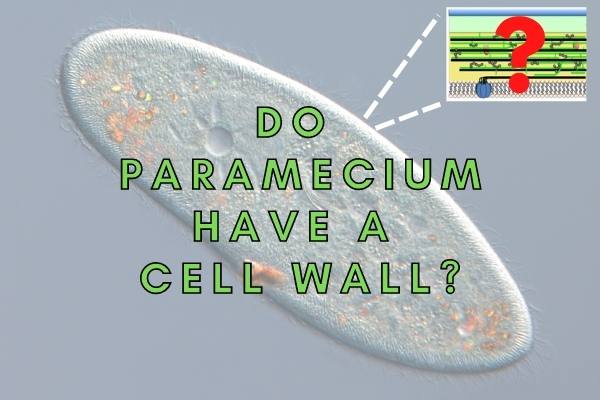Paramecium is a genus of unicellular ciliates, commonly studied as a representative of the ciliate group. Paramecia are widespread in freshwater environments and are often very abundant in stagnant basins and ponds. The body of Paramecia is a single cell that resembles that of animals more than those of plants, but it is neither and belongs to the kingdom of Protista.
Paramecium species do not have a cell wall but instead they are enclosed in a semi-rigid protective protein rich layer known as the pellicle. The pellicle is made up of three layers, the inner two of which are membranes perforated by proteins for cilia movement.
The outer two layers are made up a lattice of proteins and vesicles where the cilia of paramecium goes through.
Paramecium are some of the most interesting creatures of the microbial world. They can be seen in our water, ponds and rivers and are often mistaken for bacteria or Euglena species.
Paramecia are unicellular organisms with a single nucleus. Each cell is oval in shape, with a central vacuole and the body of the cell is covered in thin moving hairs called cilia.
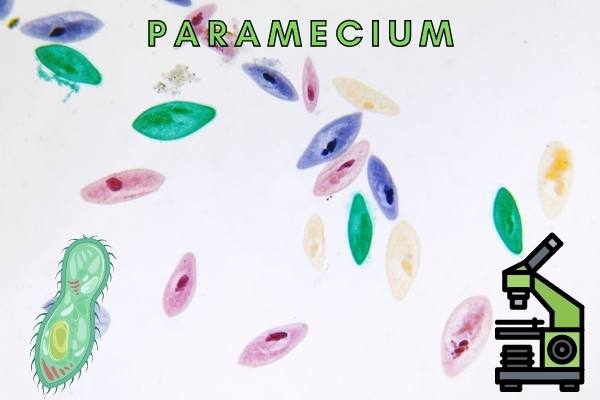
Because some species are readily cultivated and easily observed, they have been widely studied since the late eighteenth century. In 1816, Félix Dujardin provided the first illustration and description of a living paramecium under the microscope.
What is the pellicle in paramecium?
The pellicle, also sometimes called the periplast, is a thick jelly-like substance that is wrapped in the cell membrane of protozoa such as paramecium and euglena. It supports the cilia coming through and it keeps the cell shape, while still allowing movement and nutrient uptake.
The pellicle is a thin multilayered structure that covers the cell body of many protozoa. It helps to protect the cell from predators and from other environmental threats.
Just like a cell wall, the pellicle also gives the cell its shape and helps it keep the correct pressure inside the cell.
However, the pellicle is much more flexible than the cell walls of plants, bacteria and fungi. This flexibility allows for protozoa like Euglena, paramecium and the ciliate Blepharisma to change their cell shape in order to swim in water.
It also allows these protists to make cell surface extrusions to engulf their prey! This would never work if their cell surface was covered in a rigid cell wall rather than the thinner more flexible pellicle structure!
The first layer of the envelope of paramecium is thin lipid membrane, similar to that of human cells, but dotted with large sacks from where the proteins involved in cilia movement are extruded.
Above this thin membrane, separating the cytoplasm from the cell surface structures, comes the actual pellicle.
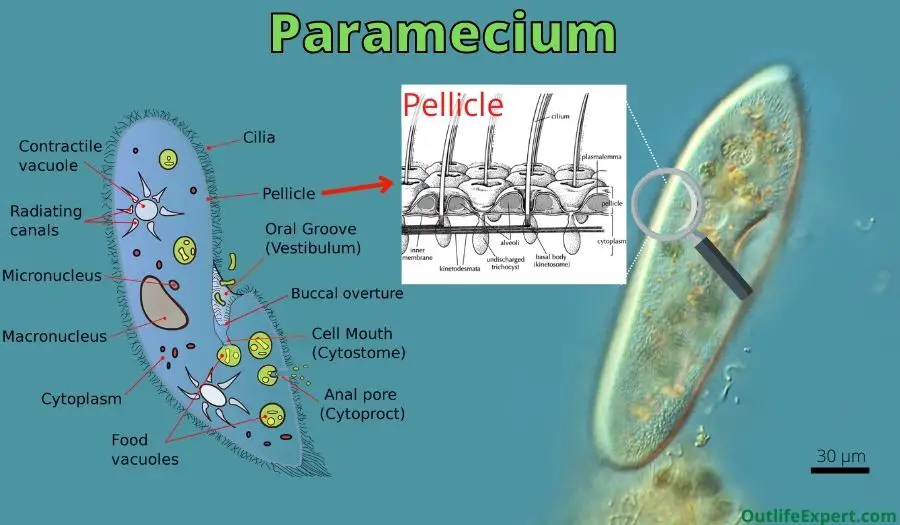
The pellicle layer is mostly made up of a membrane and protein lattice that forms what some would define as the core pellicle structure. Here, the cilia are attached and vesicles are formed to separate the outer and inner membranes.
These vesicles embedded in the pellicle are believed to store calcium ions that are used for the regulation of cilia movement!
Apart from these vesicles, pellicle membranes are composed of a variety of proteins that can bind enzymes, nucleic acids, toxins, and deter (or attract!) pathogens such as viruses.
The proteins of the pellicle are not unlike the transport channels in animals and plants but there is also a delicate network of protein fibers crossing to move the cilia.
What is the function of a pellicle in a paramecium?
Similar to the envelope of most single celled organisms, the pellicle of paramecium and other protozoa have the following important functions:
- The pellicle provides a barrier between the inside and outside of the cell.
- It helps to hold the cells together and keep the pressure inside the cell.
- The pellicle and cell membranes controls what goes in and out of the cell.
- It serves as an anchor for the proteins and cilia the makes the cell motile.
- The pellicle serves to allow transport of vesicles with food and waste in and out.
- The pellicle provides a medium for enzymatic reactions to occur in.
- The pellicle helps to keep the cell in shape.
So the main function is protection and encapsulation. This protection is needed because the cells live as single-celled organisms rather than in a larger body of protected cells like animal cells that do not need a cell wall or pellicle.
See how the pellicle aids in ciliate positioning and motility in the video below:
How does the pellicle differ from a cell wall?
The pellicle offers more protection compared to a cell membrane only, but a cell wall is much thicker, more porous and made from much more rigid materials like cellulose or peptidoglycan.
The layers of the pellicle are mostly made up of softer materials like fat with some proteins embedded, which does provide some rigidity.
All these layers make the pellicle somewhat like a cell wall that functions as a vital capsule and plays an important role in the protection of organisms from environmental stress and pathogens.
However, the cell wall of bacteria, plants and fungi is much thicker and stronger than the pellicle structure of paramecium and other protozoa.
Plants have cell walls composed of cellulose and other polysaccharides, which give them rigidity.
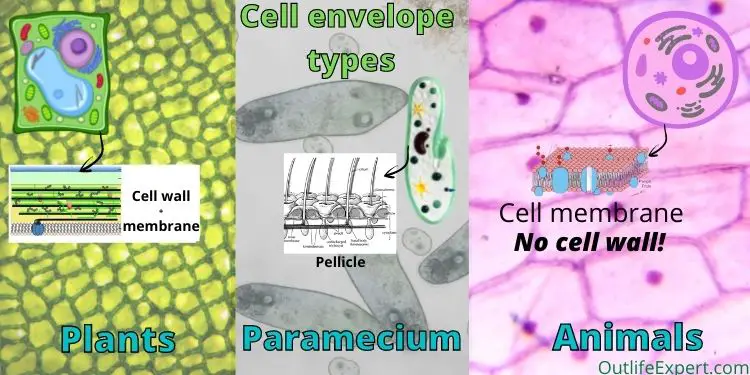
Fungi have cell walls composed of chitin, which is a polymer of N-acetylglucosamine.
Bacteria have cell walls composed of peptidoglycans, which are cross-linked polymers of sugars and amino acids.
And finally, animals do not have a cell wall at all because they are protected by the body that houses them.
All these types of cell walls are thicker and more rigid than a pellicle.
Does a paramecium have a cell membrane?
Yes, Paramecium and other protozoa have cell membranes made of single bilayers.
The cell membrane of paramecium is the outer and inner most layer of a cell that functions as a selectively permeable barrier made of lipids that control what moves into and out of the cell and encloses the pellicle.
And as we have already seen, parameciums have several membranes that are similar but do differ in their lipid and protein compositions.
The outer membrane of the paramecium is made of lipid molecules with sugars attached on the surface and anchored and embedded proteins. This outer cell membrane may look very similar to human cell membranes, except that it is more glycosylated.
The membrane of the paramecium is highly glycosylated and is considered very different from the cell membranes of animals and bacteria in structure and composition.
The membranes of bacteria are different from paramecium because unlike the pellicle, bacteria do not have vesicles that separate the cytoplasmic membrane from the cell membrane.
Bacterial membranes also contain lipopolysaccharides (LPS) that is recognized by the immune system of animals and help them form communities and adherence.
Do Euglena have a cell wall?
No, euglena do not have an ordinary cell wall but they have a pellicle similar to that of paramecium. The pellicle of euglena is different from a cell wall because it allows more flexibility so the euglena cell can move. Just as is the case for paramecium.
Like paramecium, Euglena are unicellular protozoa. However, they are not ciliates and they move using a flagella which they can power partly by sunlight!
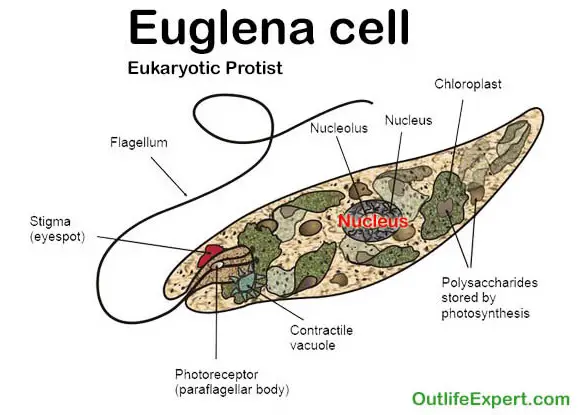
The pellicle is a layer of tough, flexible material that covers the cell surface of euglena and other protists.
It helps to protect the cell from predators and environmental stresses, and also gives the cell shape and rigidity. The pellicle can also contract and relax, which helps the cell to move.
Do all unicellular organisms have a cell wall?
No. Some bacteria and archaea, like the Mycobacteria, some archaea (see below) and many protozoa do not have a cell wall.
For example, some protozoa like Euglena, that are not quite animals and not quite plants, do not have a cell wall like plants do.
Instead, protozoa like Euglena species and paramecium ciliates have a pellicle that works a bit like a cell wall, but is not as strong and rigid as the ones of bacteria, fungi and plants!
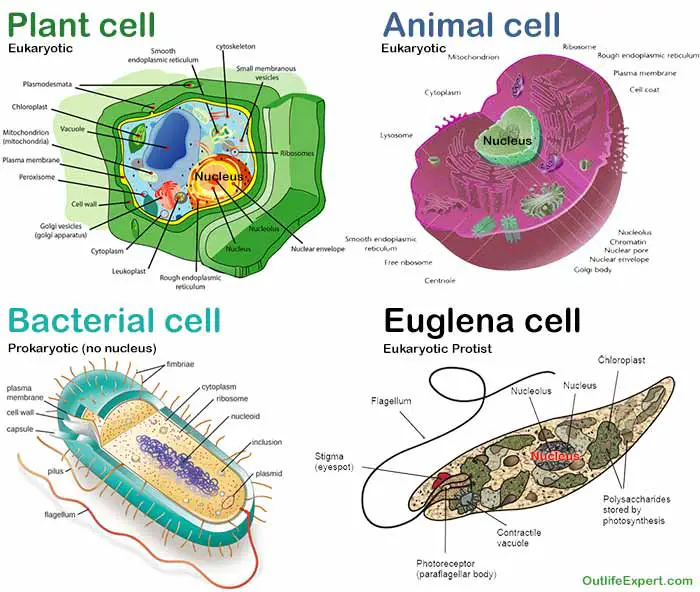
Do archaebacteria have a cell wall?
Yes! Like bacteria, the vast majority of archaea do have a cell wall.
Archaeal cell walls are rigid latice structures similar to those of bacteria that provide protection to the cell from the environment and from the internal cellular pressure.
The cell wall of archaea are often specialized in protecting the cells against extreme conditions such as high temperatures, acidity or radiation!
Most archaeal cell walls contain a proteinaceous S-layer, but some are made of pseudomurein, methanochondroitin, or a protein sheath.
However, there are examples of archaea species without cell walls!
Most archaebacteria have a cell wall composed of a unique substance called pseudomurein. This substance is made up of long chains of alternating sugar and phosphate molecules, which are bonded together by cross-links. The cell wall provides strength and rigidity to the cell, and helps to protect it from osmotic pressure.
However, one exception is some of the species of Ferroplasma and Thermoplasma.
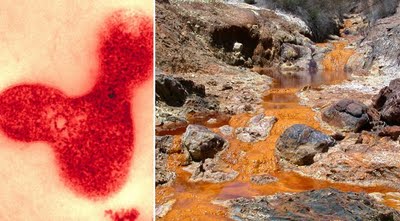
Ferroplasma and Thermoplasma are groups of thermophilic, acidophilic archaea meaning that they live in hot acid! Their cells are ovoid to spherical, and are 0.5-1.0 μm in diameter.
Do to the lack of a cell wall their cells look a bit blobby like some protozoa and they are motile, and have a single polar flagellum.
Some of thse species are obligate ferrous iron oxidizers, and can grow at pH values as low as 0.5!
It is not yet known how these archaea survive these extreme conditions without a cell wall, but their membranes are more though than those of other bacteria and archaebacteria.

